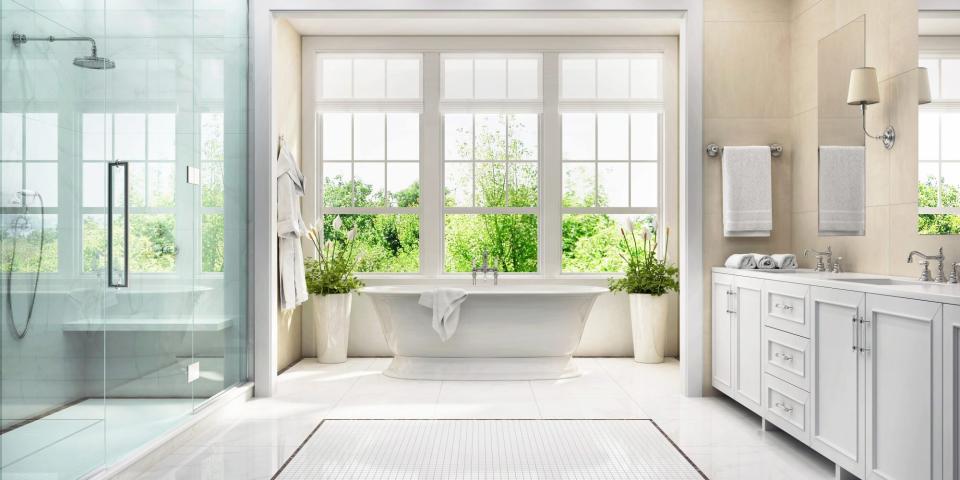How to Spring Clean the Air in Your Home
Spring cleaning usually calls for a full-home scrub-down or reorganization spree to effectively refresh spaces post-winter. While you've likely already started your to-do list for the season, there is something you might have forgotten to prioritize cleansing: the air in your home. Marilee Nelson, a certified building biologist, environmental consultant, and the co-founder of Branch Basics, says to approach this process by asking yourself the following queries: Do you have a family member with respiratory issues, frequent colds, the flu, headaches, dizziness, irritated eyes, nose or throat, fatigue, allergies, or any chronic physical problems? Do you grow exhausted and sleepy during the day? Do you have any materials and products in your home or attached garage with harmful VOCs that pollute the air? "If you answered yes to any of these questions, then this is a call for action to clean up your home's air quality," she says.

sl-f / Getty Images
Even everyday actions can contribute to low air quality, especially come springtime. Jonas Holst, the chief product officer at Blueair, explains that vacuuming, dusting, cooking, or playing with your pet can actually release pollutants into your air. And since harmful germs and viruses—COVID-19 in particular—can easily circulate within your interior, prioritizing its air is a must to keep your space fresh and safe. Ahead, several expert-approved ways to ensure your air is at its best every time spring rolls around.
Related: The Best Plants to Purify the Air in Your Home
Open Up Your Doors
The first step to spring cleaning your air is an easy one. "Because indoor air is on average five times more polluted than outdoor air, your best defense against indoor air pollution—especially if you are tackling any spring cleaning—is to open your windows and create a well-ventilated space to keep fresh, clean air flowing," Holst says. Alan Reppert, a senior meteorologist at AccuWeather, also suggests checking your pollen and weather forecasts regularly to know when peak blooming times are, so those with allergies or asthma can be on alert when particles could potentially enter the home.
Use an Air Purifier
After ventilating your space, switch on an air purifier to go the extra mile. This is especially important after a vacuuming or dusting session. "Part of the issue is that your house will collect dust and dirt over time, but dusting, sweeping, and vacuuming will kick up particles in the air," Reppert notes, recommending the Dyson Pure Hot+Cool HP04 Purifying Heater and Fan ($649.99, target.com). This machine regulates a room's temperature while it filters particles and even smoke out of the air. Monitor your home's air quality even more closely via Homedics' Total Clean Five-in-One Tower Air Purifier ($216.55, amazon.com); it automatically catches particles and has an adjustable three-speed setting.
To combat dangerous germs, Holst suggests Blueair's HealthProtect air purifiers, which have been tested against the SARS-CoV-2 virus with success. Ultimately, though, "you should choose an air purifier capable of changing the air in your room five times per hour," Holst advises. "To get the right size, measure your room and look at the CADR (which stands for Clean Air Delivery Rate). This measures an air cleaner's effectiveness based on room size and the volume of clean air produced per minute." CADR also takes note of how the dust, pollen, and smoke, (which are the three most common indoor air pollutants), are removed from your air. For a smaller space (think: medium-size bedrooms or family rooms), consider the HealthProtect 7410i ($639.99, target.com); this option cleans 418-square feet of of germs, allergens, and gas in 12 minutes. The HealthProtect 7770i ($839.99, target.com) filters 674-square feet every 12 minutes, so it would be perfect for extra-large family rooms, basements, or open floor plans.
Get Rid of Toxic Chemicals
"Removing products with harmful chemicals from your home is a simple, no-cost, fast, dramatic way to reduce indoor pollution and improve air quality," Nelson says. "Most Americans have materials and products throughout their homes that contain harmful chemicals, which could make the air inside up to 500 times more polluted than outside air." This means the air pollution is seeping into closets, drawers, cabinets, and garages. Nelson notes that these immune stressors make a low-level "chemical soup" that will pollute the air nonstop if you don't ventilate your home. According to the United States Environmental Protection Agency (EPA), indoor air quality can be a top threat to health—which is why Nelson advises switching to all-natural cleaning products. Consider non-toxic formulas, like the ones in the Branch Basics Premium Starter Kit ($69, branchbasics.com).
Vacuum Your Spaces
Nelson notes that certified-sealed HEPA vacuums can improve your air quality since they prevent harmful bacteria, like heavy metals, VOCs, SVOCs, and biocides, from reentering your home when you're cleaning. The Nilfisk GM 80 HEPA vacuum ($1,449.99, amazon.com) is her favorite. "They're lightweight but built to last several generations with commercial-level durability," Nelson explains. "Nilfisk HEPA vacuums are actually used to clean the NASA cleanrooms, spaceships, and shuttles, and are used in the mold, lead, and asbestos abatement industry." Alternatively, you can rent these machines each spring for an extra-deep clean. Otherwise, "Shark's Apex Powered Lift Away ($379, amazon.com) is the most economical option with a sealed system—I have personally tested it and can vet that it has excellent cleaning power," she adds. "I would choose this vacuum over a fancier one without a sealed HEPA system every time."
Change Air Filters
Lastly, when spring officially rolls around, switch out air filters in your heating system and air conditioner. "Replacing these filters regularly will prevent added pollutants such as dust, mites, and bacteria from circulating in your house," notes Reppert. Holst adds that you should replace pleated air filters and furnace filters every 90 days.

